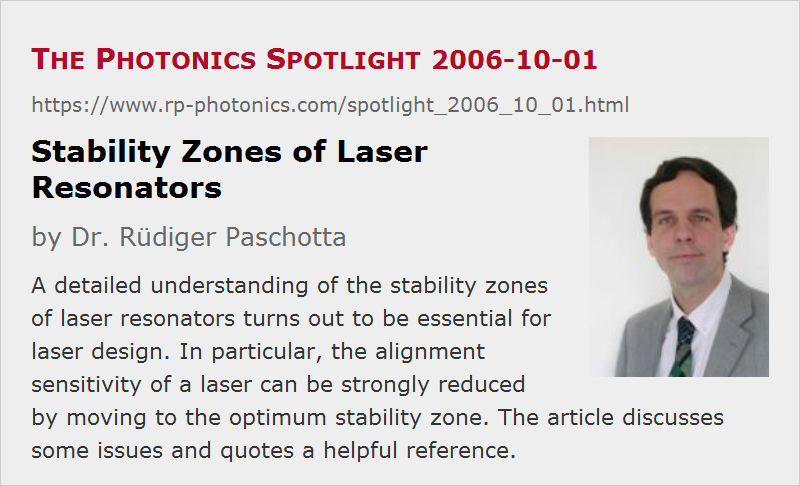Stability Zones of Laser Resonators
Posted on 2006-10-01 as a part of the Photonics Spotlight (available as e-mail newsletter!)
Permanent link: https://www.rp-photonics.com/spotlight_2006_10_01.html
Author: Dr. Rüdiger Paschotta, RP Photonics Consulting GmbH
Abstract: A detailed understanding of the stability zones of laser resonators turns out to be essential for laser design. In particular, the alignment sensitivity of a laser can be strongly reduced by moving to the optimum stability zone. The article discusses some issues and quotes a helpful reference.

Ref.: V. Magni, “Multielement stable resonators containing a variable lens”, JOSA A 4 (10), 1962 (1987); encyclopedia articles on stability zones, resonator design, laser design, alignment sensitivity of optical resonators, and others
It is well known that laser resonators exhibit stability zones, i.e. well-defined regions for parameters like a cavity arm length or the focusing power of an intracavity element, in which stable cavity modes exist. A linear optical resonator normally exhibits two such stability zones, even though one may observe only a single one under certain circumstances. While both stability regions have the same width e.g. in terms of focusing power of the thermal lens in the gain medium, they otherwise have very different properties. In particular, they can be very different concerning the alignment sensitivity of a laser. I have myself encountered an extreme case where a laser was very hard to align due to strong thermal effects in the gain medium. When I completely redesigned the laser resonator to operate in the other stability zone, it generated more than twice the output power and was much less critical to align. Note that the mode size was nearly unchanged compared to the original design, so the mode size is clearly not all what matters.
The mentioned fundamental resonator properties have been analyzed in detail in the paper cited above. As many people are not familiar with these details, they get one of the stability zones of their resonators just at random, and may therefore easily end up with a non-ideal design. With refined software, it is possible to systematically design laser resonators operating at the stationary point of the wanted stability zone while simultaneously meeting several other requirements.
This article is a posting of the Photonics Spotlight, authored by Dr. Rüdiger Paschotta. You may link to this page and cite it, because its location is permanent. See also the RP Photonics Encyclopedia.
Note that you can also receive the articles in the form of a newsletter or with an RSS feed.
Questions and Comments from Users
Here you can submit questions and comments. As far as they get accepted by the author, they will appear above this paragraph together with the author’s answer. The author will decide on acceptance based on certain criteria. Essentially, the issue must be of sufficiently broad interest.
Please do not enter personal data here; we would otherwise delete it soon. (See also our privacy declaration.) If you wish to receive personal feedback or consultancy from the author, please contact him e.g. via e-mail.
By submitting the information, you give your consent to the potential publication of your inputs on our website according to our rules. (If you later retract your consent, we will delete those inputs.) As your inputs are first reviewed by the author, they may be published with some delay.
 |



If you like this page, please share the link with your friends and colleagues, e.g. via social media:
These sharing buttons are implemented in a privacy-friendly way!